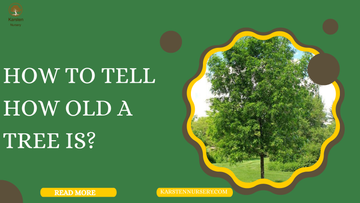Types of Maple Trees and How to Choose the Right One for Your Yard
by Joel Karsten on Jun 18, 2025

Maple trees are beloved for their beauty, brilliant fall foliage, and versatility. Whether you're eyeing curb appeal or a vibrant splash of autumn color, the types of maple trees you pick can make all the difference.
Let’s dig into the most popular maple tree varieties—and help you choose the perfect one for your yard.
What Are the Different Types of Maple Trees?
There are over 100 maple tree species around the world, but only a handful make regular appearances in North American landscapes. These different kinds of maple trees range from towering giants to dainty ornaments.
Popular Maple Tree Types Include:
-
Sugar Maple (Acer saccharum) – Classic fall color, native to North America
-
Red Maple (Acer rubrum) – Fast-growing and adaptable
-
Silver Maple (Acer saccharinum) – Great shade, but known for weak wood
-
Japanese Maple (Acer palmatum) – Small and ornamental with stunning leaf shapes
-
Amur Maple (Acer ginnala) – Hardy and compact, ideal for small yards
-
Norway Maple (Acer platanoides) – Common but considered invasive in some areas
How to Identify a Maple Tree in Your Yard?
Wondering if that tree dropping colorful leaves in your yard is maple? Identifying maple tree types is easier than you think.
Here’s how to tell:
-
Leaves: Maple tree leaves are lobed with pointed tips, often resembling a hand.
-
Seeds: Look for winged seeds called samaras (or "helicopters").
-
Bark: Young trees often have smooth bark; older trees may have furrowed or ridged textures.
-
Color: In fall, maple tree varieties explode into red, orange, and yellow hues.
Which Maple Tree Is Best for Front Yard Landscaping?

For front yard charm, you'll want a maple tree variety that blends beauty and manageability. Here are top contenders:
-
Japanese Maple: Ideal for small spaces with stunning ornamental value.
-
Red Maple: Offers fast growth and bright fall color.
-
Amur Maple: Compact and tidy, with fiery autumn foliage.
Quick-Specs Box
-
Grows 10–25 ft tall
-
Minimal maintenance
-
Great for accent planting
-
Non-invasive roots (mostly)
These pretty maple trees instantly elevate curb appeal and frame your home beautifully.
What Kind of Maple Tree Grows Fastest?
If you’re after shade or privacy fast, you need a speedy grower.
Silver Maple is your winner here.
-
Grows up to 3 feet per year
-
Reaches 50–80 feet tall
-
Tolerates a range of soils
-
Loves moist locations
The Red Maple is a close second. It grows quickly (1–2 feet per year) and delivers those iconic fall shades.
Best Maple Trees for Fall Color
When autumn hits, maple trees put on a show like no other. Some kinds of maple outshine the rest.
Top Picks for Fall Foliage:
-
Sugar Maple – Gold, orange, and red
-
Red Maple – Deep scarlet
-
Amur Maple – Crimson and rust
-
Japanese Maple – Burgundy to bright red
Quick-Specs Box
-
Sugar Maple: Large and classic
-
Japanese Maple: Compact, ornamental
-
Red Maple: Vibrant, fast-growing
-
Amur Maple: Small but fiery
How to Choose a Maple Tree for Small Spaces?
Not all maples are massive. Some different kinds of maple fit neatly into small gardens or tight urban lots.
Best Choices:
-
Japanese Maple – Under 25 feet, graceful shape
-
Amur Maple – Multi-stemmed, shrub-like
-
Paperbark Maple – Peels bark for extra interest
Quick-Specs Box
-
Mature Height: 10–20 feet
-
Root Spread: Minimal
-
Light Needs: Partial to full sun
-
Maintenance: Low
Small doesn’t mean boring. These varieties of maple pack a punch in pint-sized packages.
Maple Trees That Thrive in Cold Climates

Cold-Hardy Maple Trees:
-
Sugar Maple – Hardy to Zone 3
-
Amur Maple – Cold-tolerant and compact
-
Red Maple – Performs well in Zones 3–9
Quick-Specs Box
-
Frost Resistance: High
-
Leaf Retention: Good
-
Soil Flexibility: Moderate to high
-
Snow Load Tolerance: Strong branches (except Silver Maple)
Difference Between Red Maple and Sugar Maple
Let’s clear up one of the most common confusions: Red Maple vs Sugar Maple.
Sugar Maple (Acer saccharum)
-
Leaves: 5 lobes, smooth edges
-
Sap: Used for maple syrup
-
Color: Orange to red
-
Bark: Dark and ridged with age
Red Maple (Acer rubrum)
-
Leaves: 3–5 lobes, toothed edges
-
Sap: Watery, less sweet
-
Color: Deep red in fall
-
Bark: Light gray, smoother in youth
Quick-Specs Box
|
Feature |
Sugar Maple |
Red Maple |
|
Growth Rate |
Moderate |
Fast |
|
Fall Color |
Orange/Red |
Bright Red |
|
Hardiness |
Zone 3–8 |
Zone 3–9 |
|
Syrup Production |
Yes |
Rarely |
Pros and Cons of Planting a Silver Maple
Pros:
-
Rapid growth
-
Large canopy = serious shade
-
Adaptable to wet soils
Cons:
-
Brittle limbs
-
Invasive roots
-
Shorter lifespan
Quick-Specs Box
-
Height: 50–80 feet
-
Spread: 35–50 feet
-
Growth Rate: Very fast
-
Lifespan: ~80 years
If you're eyeing different types of maple for large landscapes, Silver Maple works—just don’t plant it too close to buildings or sidewalks.
Final Thoughts: Choosing the Right Maple Tree for Your Yard
With so many different species of maple trees, it really boils down to your space, climate, and what kind of vibe you're going for. Want fast shade? Try a Red or Silver Maple. Need something compact and classy? Japanese or Amur Maples are your best bets.
Karsten Nursery has been helping farmers and ranchers across the U.S. grow vibrant, healthy trees and shrubs. As a family-owned production nursery founded by Glen Karsten, we take pride in offering quality plants backed by generations of horticultural knowledge.
Visit our website and shop now.
FAQs
Q: How many varieties of maple trees are there?
There are over 130 species of maple trees (genus Acer) worldwide. While not all are native to North America, around a dozen are commonly used in landscaping across the U.S. and Canada.
Q: What do maple trees look like?
Maple trees are best known for their distinctive lobed leaves, often shaped like a hand with pointed "fingers." They typically grow with a rounded or oval canopy, and many species show brilliant fall foliage in shades of red, orange, and yellow.
Q: When to prune maple trees?
The best time to prune maple trees is late winter to early spring, before sap starts flowing—usually between February and early March, depending on your climate. Avoid pruning in early spring when the sap is running heavily, as this can cause messy "bleeding."
Q: What does a maple tree look like?
A mature maple tree usually has a broad canopy, opposite-branching limbs, and those classic palm-shaped leaves. In autumn, many maple species display fiery colors like scarlet, gold, or orange. In spring and summer, the foliage is typically green, though some varieties like Japanese Maple may have purple or red leaves year-round.
Q: How fast do maple trees grow?
It depends on the species: Silver Maple: Very fast (up to 3 feet per year), Red Maple: Fast (1–2 feet per year), Sugar Maple: Moderate (1 foot per year) Japanese Maple: Slow (less than 1 foot per year)
Q: How long do maple trees live?
Most maples live between 80 to 150 years, depending on the species and growing conditions. Sugar Maples can live well over a century, while Silver Maples tend to have shorter lifespans—closer to 60–90 years.
Q: How do I tell what type of maple tree I have?
You can identify your maple tree type by looking at: Leaf shape and edge pattern, Bark texture and color, Seed shape (samaras) and Tree size and branching pattern.
Q: What is the most common type of maple tree?
The Red Maple (Acer rubrum) is the most common and widely distributed maple tree in North America. It’s popular for landscaping due to its fast growth, tolerance to different soils, and vibrant red foliage in fall.
Q: What branches do you trim on a maple tree?
When pruning maple trees: Trim dead, damaged, or diseased branches, Remove crossing or rubbing limbs, Thin out crowded sections to improve airflow and Never remove more than 25% of the tree’s crown in one season.
Read more relevant blogs as well. How to Protect Plants from a Freeze?
How to Protect Plants from a Freeze?




